562 Search Results for home
July 30, 2015
by Carole Zangari -
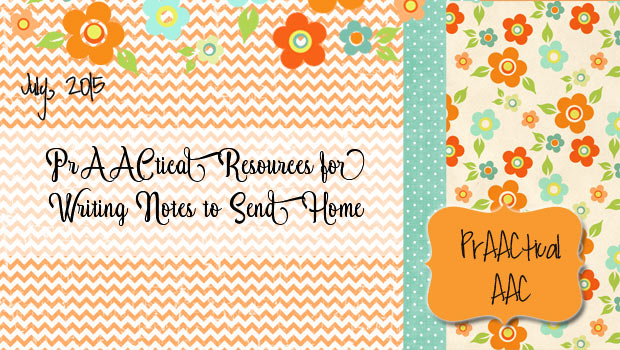
When children arrive home from school, they are often asked some version of ‘the’ question: “What did you do in school today?” A few years ago we wrote about strategies families can use to help facilitate that conversation and were so pleased to hear from school staff who took this to heart and helped their students practice these conversational skills. As busy as life in the classroom can be, many teachers and SLPs make the time to communicate with families about the students’ day at school and we love seeing their work. There are many ways to give daily/weekly updates, of course, but many use the tried-and-true strategy of sending a note home. There are lots of examples on the wonderful sharing site for Boardmaker Online. Here are some of them. 1. Katie Crayons 2. Orange County PS1 3. TASN Autism and Tertiary Behavior Supports 4. Megan Little 5. Evet Bresseas 6. Kristen Schmidt (English... [Read More...]
June 2, 2015
by Carole Zangari -

Jill Senner and Matthew Baud are back to share some of their favorite therapy activities. In this post, they discuss how they build language while making ice cream. Summer is almost here and we’re already thinking about making our favorite frozen treat, ice cream in a bag. No special equipment is required. With a couple of plastic zipper bags and 5 ingredients already in your kitchen, kids can shake milk into ice cream in just 5 minutes. Free picture recipes can be downloaded here. As with many of the cooking activities we love, there are lots of natural opportunities for language use before, during and after cooking. Before cooking we read the recipe and check the kitchen to see if we have the ingredients. If any are missing, we write shopping lists of ingredients we need. We can take a community field trip to the grocery store where there... [Read More...]
September 7, 2014
by Carole Zangari -

Today we head to Australia to see some great examples of communication support in the daily lives of women in a group home. Enjoy this video by Inner South Communication Service. Direct link to video: https://www.youtube.com/watch?v=PljrI54od6A&app=desktop
May 12, 2014
by Robin Parker -
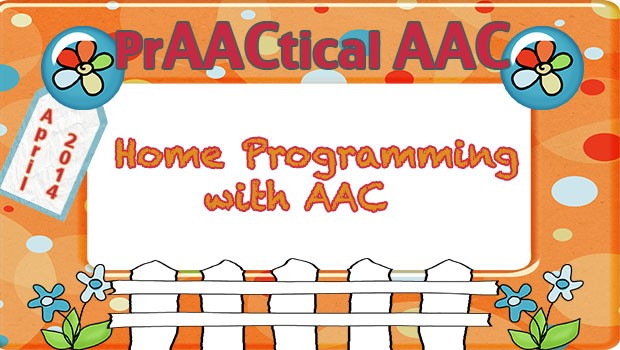
As SLP’s we love to have families learn and carryover the work we do in speech-language treatment sessions. This helps ensure carryover of progress and generalization of therapy success. However, as Carole clearly illustrated last Monday, there are a lot of family dynamics, cultural issues, and family challenges that make adding extra work possibly burdensome. We really (really) do not want to burden families, but its beneficial to have AAC communication happen all day long. We once had a client who had a very huge house with lots of bedrooms, but mom chose to keep her children together in one bedroom. This was just in case the AAC user woke in the middle of the night. Then she would have someone close by as a communication partner. This was a family who took home programming to the max and expanded and modified it to fit their family. A main issue... [Read More...]
July 25, 2013
by Carole Zangari -
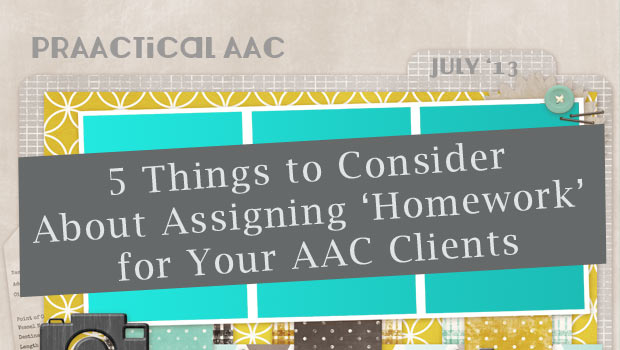
Practicing skills outside of therapy is a good way to extend the learning process and generalize skills to functional environments. It isn’t appropriate for every situation, but when it is, here are some things we try to think about. 1. It should focus on skills they have, not ones they need to learn. Why? Because when we’re learning new things, we get it wrong fairly often. And we don’t want to give them practice getting it wrong. Instead, the home practice should be on things they know and can do, but don’t do consistently. Home practice is a great way to build fluency and automaticity. 2. Tie it into the client’s interests. Use materials or topics that they enjoy. 3. Teach it. Resist the temptation to quickly go over the home practice in the last 60 seconds of therapy or in the waiting room. We’ve all done it, but strive... [Read More...]
July 2, 2013
by Carole Zangari -
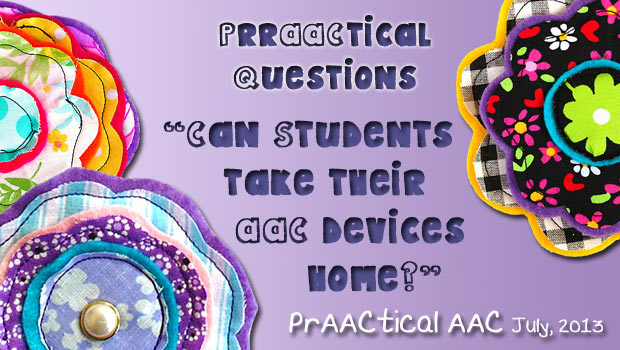
Yes. Although this question was settled definitively in 1991 by US Special Education Programs former director Judith Schrag, there are still some misinformed professionals saying otherwise. In most cases, administrators cannot limit AAC device use to school grounds only. As long as the team agrees that the student needs to be able to communicate throughout the day, then the AAC device can go home in the afternoon, on weekends, on holiday breaks, and during the summer. The “Schrag Letter” (OSEP, November 27, 1991) asserted that “if the IEP team determines that a particular assistive technology item is required for home use in order for a particular child to be provided Free Appropriate Public Education, the technology must be provided to implement the IEP.” There may be an IEP team out there somewhere who feels that a student only needs to communicate during the 6-hour school day, but we haven’t met... [Read More...]
April 1, 2012
by Carole Zangari -
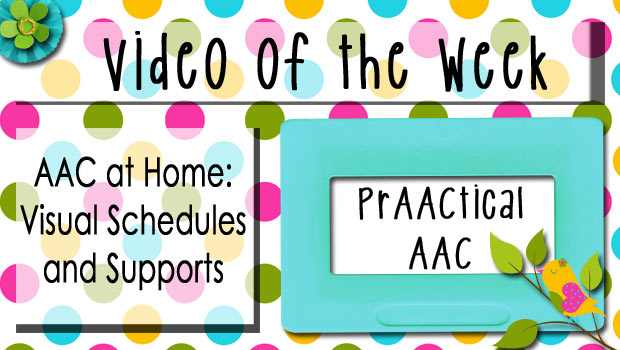
These videos from Autism House (in Indiana) have some great illustrations of using visual schedules and calendars at home. If you’re looking for different kinds of examples, these videos are for you. Click here for Part 1 and here for Part 2. —
May 11, 2025
by Carole Zangari -
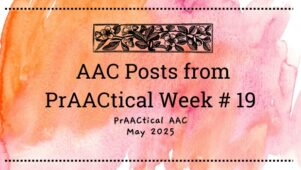
Happy Sunday, AAC friends, and a fulfilling Mother’s Day to those who are celebrating today. We have some posts that may be of interest. Tuesday – AAC Link Up Wednesday – Video of the Week: Supporting AAC at Home Have time for a little more? Here are a couple of suggestions. A Focus on Self-advocacy AAC Funding Help Building Your AAC SLP Toolkit: Obtaining Free Apps for AAC Evaluations Check Your Knowledge of AT History AACtual Therapy: Making Core Words Fun for Students with Autism AAC Goes to Summer Camp
March 23, 2025
by Carole Zangari -
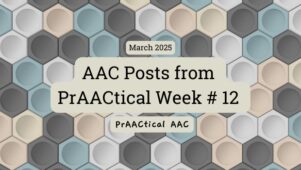
Happy Sunday, AAC friends. We have some posts you may enjoy. Tuesday – AAC Link Up Wednesday – Video of the Week: Unspoken Voices and More Thursday – PrAACtical Considerations: Prestored Messages in AAC, Part 1 :::::::::::::::::::::::::::::::::::::::::::::::::::::::::::::::::::::::::::::::::::::::::::::::::::::::::::::::::::: Looking for some AAC materials? We pulled out a few from the AAC Toolbox just for you. Spelling Boards & FlipBook– Letter boards (alpha & QWERTY) used at Camp Alec; Created by Tina Moreno Communicare Language Board Templates – Communication board templates for the post “How We Do It: Using Language Boards to Support AAC Use” Colorful Connections – Templates for teaching modified Fitzgerald Key and Goossens’, Crain, & Elder color-coding schemas And here’s a post from the past that you might like. Readiness: 7 Days of AACtion
March 5, 2025
by Carole Zangari -

What is the role of core and fringe vocabulary for beginning communicators? In today’s featured video, we learn about this topic from Bethany Frick Semmler. We are grateful to Bethany for this information and to USSAAC and ISAAC for hosting this webinar. Direct Link to Video – https://www.youtube.com/watch?v=W6Z2ZJr4j1w&ab_channel=InternationalSocietyforAugmentativeandAlternativeCommunication%28ISAAC%29









